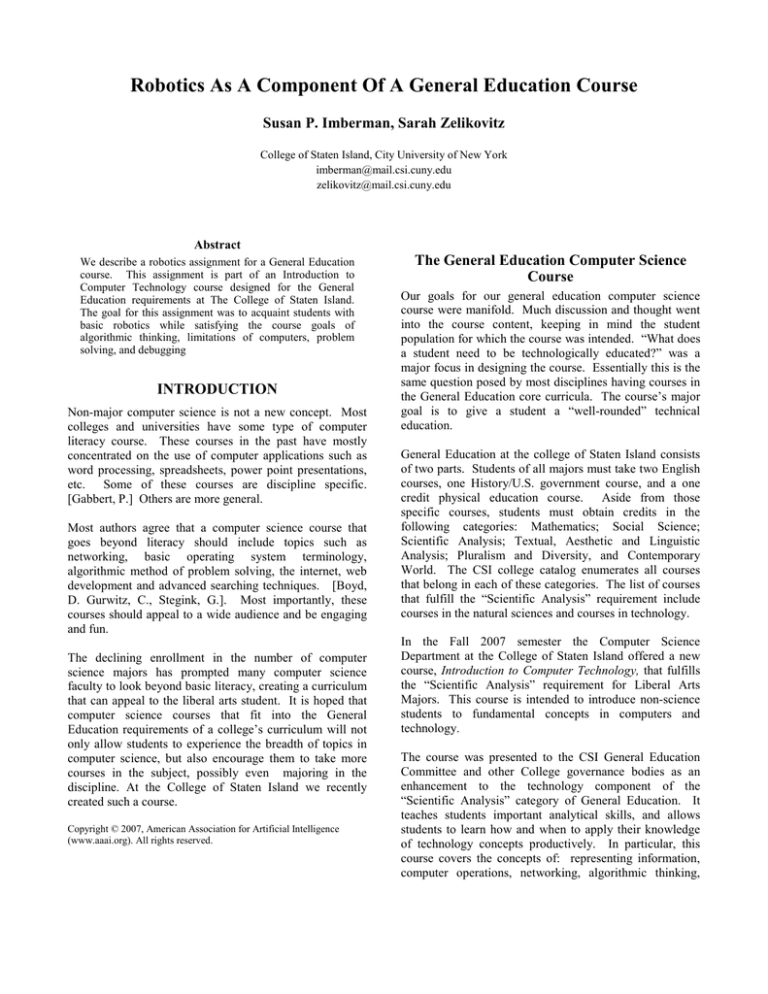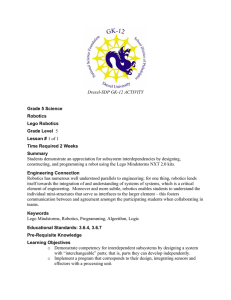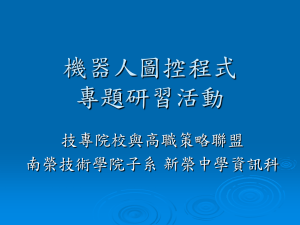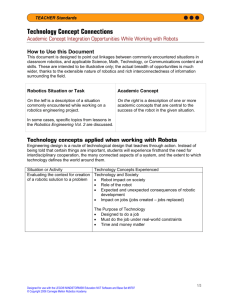
Robotics As A Component Of A General Education Course
Susan P. Imberman, Sarah Zelikovitz
College of Staten Island, City University of New York
imberman@mail.csi.cuny.edu
zelikovitz@mail.csi.cuny.edu
Abstract
We describe a robotics assignment for a General Education
course. This assignment is part of an Introduction to
Computer Technology course designed for the General
Education requirements at The College of Staten Island.
The goal for this assignment was to acquaint students with
basic robotics while satisfying the course goals of
algorithmic thinking, limitations of computers, problem
solving, and debugging
INTRODUCTION
Non-major computer science is not a new concept. Most
colleges and universities have some type of computer
literacy course. These courses in the past have mostly
concentrated on the use of computer applications such as
word processing, spreadsheets, power point presentations,
etc. Some of these courses are discipline specific.
[Gabbert, P.] Others are more general.
Most authors agree that a computer science course that
goes beyond literacy should include topics such as
networking, basic operating system terminology,
algorithmic method of problem solving, the internet, web
development and advanced searching techniques. [Boyd,
D. Gurwitz, C., Stegink, G.]. Most importantly, these
courses should appeal to a wide audience and be engaging
and fun.
The declining enrollment in the number of computer
science majors has prompted many computer science
faculty to look beyond basic literacy, creating a curriculum
that can appeal to the liberal arts student. It is hoped that
computer science courses that fit into the General
Education requirements of a college’s curriculum will not
only allow students to experience the breadth of topics in
computer science, but also encourage them to take more
courses in the subject, possibly even majoring in the
discipline. At the College of Staten Island we recently
created such a course.
Copyright © 2007, American Association for Artificial Intelligence
(www.aaai.org). All rights reserved.
The General Education Computer Science
Course
Our goals for our general education computer science
course were manifold. Much discussion and thought went
into the course content, keeping in mind the student
population for which the course was intended. “What does
a student need to be technologically educated?” was a
major focus in designing the course. Essentially this is the
same question posed by most disciplines having courses in
the General Education core curricula. The course’s major
goal is to give a student a “well-rounded” technical
education.
General Education at the college of Staten Island consists
of two parts. Students of all majors must take two English
courses, one History/U.S. government course, and a one
credit physical education course. Aside from those
specific courses, students must obtain credits in the
following categories: Mathematics; Social Science;
Scientific Analysis; Textual, Aesthetic and Linguistic
Analysis; Pluralism and Diversity, and Contemporary
World. The CSI college catalog enumerates all courses
that belong in each of these categories. The list of courses
that fulfill the “Scientific Analysis” requirement include
courses in the natural sciences and courses in technology.
In the Fall 2007 semester the Computer Science
Department at the College of Staten Island offered a new
course, Introduction to Computer Technology, that fulfills
the “Scientific Analysis” requirement for Liberal Arts
Majors. This course is intended to introduce non-science
students to fundamental concepts in computers and
technology.
The course was presented to the CSI General Education
Committee and other College governance bodies as an
enhancement to the technology component of the
“Scientific Analysis” category of General Education. It
teaches students important analytical skills, and allows
students to learn how and when to apply their knowledge
of technology concepts productively. In particular, this
course covers the concepts of: representing information,
computer operations, networking, algorithmic thinking,
limitations of computers, problem solving, debugging,
privacy, security. The goal of the course is to have
students understand the theory and science behind
technology concepts. These concepts are taught with
weekly or bi-weekly complementary lab exercises that
allow students to apply newly learned methodological
techniques by using current web-based technology,
software and applications.
In particular, the labs in the course included: searching
with, and comparison of, different search engines,
diagnosis of hardware problems and BIOS settings
analysis, use of software to gather network statistics and
information, HTML and JavaScript programming, analysis
of path algorithms using local maps and java applets, using
techniques to evaluate security of computers and websites,
evaluation and experimentation with speech recognition
software, and robotics.
Since the course is in the “Scientific Analysis” category of
General Education, all lab exercises needed to follow the
scientific method. Many of the labs have a discovery
phase, where students read articles, follow links, or try
applets to learn about the problem that they are exploring.
Many of the labs, too, include the creation of a hypothesis
and the testing of that hypothesis. For example, the speech
recognition lab explores word error rates with different
passages, and different users. Students hypothesize which
passage and which user would have the lowest error rate
based upon their knowledge of speech recognition
programs, and then test their results.
For our robotic assignment, we needed a robot whose
architecture was a minimum of two motors, the NXT brick,
and a light sensor. Keeping in mind the need to engage the
student, we decided to go beyond our basic needs and build
a more complex robot. The Mindstorm kit comes with
instructions on how to build such a robot. Our robot
followed the LEGO® design. Figure 1 is a picture of a
complete robot. As one can see from the figure, it is no
wonder that students tended to anthropomorphize this
robot. Its appearance is one that you would traditionally
expect a robot to be, i.e. humanistic. It is definitely a much
“cooler” and engaging architecture than two motors, and
one sensor. Another reason for the enhanced architecture
is our intention to use the platform in other classes. Thus,
this architecture gives us much flexibility in this regard.
Another factor influencing our decision to use the NXT
was the graphical programming language, written for this
platform. Unlike text based programming languages, the
NXT graphical language, based on Lab View, allows
students to program complex robot behaviors with a few
graphical blocks. This is done by modifying parameters
associated with each block. The language allows for
complicated programming constructs such as loops and
decisions in a way that is easy for the nonprogrammer to
grasp. Figure 2 shows an NXT graphical program that will
move a robot in a box-like path.
Other materials needed for this project were white foam
board, black masking tape, and green art paper. Materials
were basically inexpensive. Each Mindstorm kit costs
~$250, and the art materials cost about $75. We used 15
Students are required to write a report after the completion
of each lab. The lab report components are: introduction
and objective, description, observations, results, and
references. This lab report forces students to think about
the objective of each lab, and to review what they have
done, why they have done it, and what they have learned
from it. These reports help students focus on the important
aspects of the labs as they are completing the labs.
Robotics has become an integral part of the computer
science curriculum at The College of Staten Island (CSI).
We have had much success integrating robotics into our
CSI class and our Artificial Intelligence class. [Imberman,
Imberman and Klibaner] Students at both the advanced
and introductory levels found the robotics component
engaging, interesting, and fun. Hence, it was only natural
to include a robotics assignment into the new General
Education course.
The NXT
We chose the new LEGO® Mindstorm NXT as the robotic
platform for this course. The educational Mindstorm kit
comes with all that is needed to construct a basic robot.
Figure 1 – NXT Robot
robot is discussed with mention of famous robots of fact
and fiction. The current state of robotic applications is
explored with an emphasis on the Mars rovers. We
emphasized this because the final task in the project was to
program the NXT to “find life” on Mars.
The project starts with a one move block program. When a
block is selected, as is the first block is in Figure 2, the
screen displays several parameters.
Students are
encouraged to experiment with each of these, noting their
observations as to the robot’s behavior. Students then add
more move blocks to get more interesting robot
movements.
Figure 2 – Screen shot of NXT program
NXT kits, with two or three students sharing a robot.
Therefore our total expense was less than $4,000.
The NXT Gen Ed Project
In developing this project we had several desired goals.
First the lab was designed to address the course goals of
algorithmic thinking, limitations of computers, problem
solving, and debugging. Second, we wanted to create a
hands-on exercise that would be challenging but not
frustrating. Third, we also wanted to connect what the
students did in the laboratory to robotics in the real world.
Since the course was part of the Scientific Analysis group
in the college’s general education curriculum, projects had
to follow the scientific method. Thus, fourth, our project
had to allow for some experimentation. But the real
challenge was accomplishing all of this during a two hour
lab period!
The concept of a loop is easy to implement using a loop
block. The Going Loopy task instructs the students on the
benefits of being able to repeat tasks in a computer
program. The students place two move blocks inside a
loop block and are instructed to experiment and adjust the
move block parameters so the robot moves in a box
pattern. This is the program displayed in Figure 2. It is
easy to see graphically that the blocks inside the orange
loop are repeated. We only use continuous loops in this
lab and don’t explore other loop concepts such as variable
controlled loops. Robot programs are stopped by pressing
the gray back button on the NXT.
The next task explores the light sensor. The concept of
sensor calibration is described. Students are told to use the
NXT’s help files to learn how to calibrate the light sensor.
When the NXT is connected to the computer, and a light
sensor block is selected, the readings from the sensor are
visible under the hour glass in the lower left of the
parameter panel, Figure 3. Students were told to see what
light reading they obtained by placing, black, white, and
green paper under the sensor.
At the lab session prior to the NXT project, a half hour was
spent introducing the components of the robot, describing
the hardware, input/output ports, and allowing the students
to play with the robots. Students tried the sensors, and
learned how to download a short program onto the NXT.
By the time students entered lab to create their projects, the
NXT robot was a bit familiar, and students understood
some of the hardware components and some of the major
steps of using the software.
Each project for this class included an introductory section
which provided background information relevant to the
project. The robotic lab’s introduction gave a basic
definition of the field of artificial intelligence and its
relationship to robotics. The concept of what constitutes a
Figure 3 – Light sensor block
The until parameter sets a threshold value that the robot
waits for, before continuing onto the next block in the
program. Students are directed to adjust this parameter to
detect black and to play a sound or phrase using the sound
block, placing it onto the sequence beam after the sensor
block. The task is expanded to require students to move
the robot along a white foam board road with black stripes.
Each time a black stripe is encountered the robot is to
make some noise indicating it found black. Figure 4
depicts this striped road.
Figure 5 Our Martian Landscape
NASA via its communication device (the sound block).
Figure 5 depicts our Martian landscape.
Lab directions are written in a step by step format, with no
assumptions made with respect to the student’s prior
knowledge. Instructions are annotated with many screen
shots and photographs. The complete project description
can be found at:
http://www.cs.csi.cuny.edu/~imberman/gened/Robotics.pdf
SUMMARY AND DISCUSSION
Figure 4 Black striped road
From here we create Mars rovers. It doesn’t take much to
modify the black stripe seeking program to one that
explores Mars. The premise is that the student’s Mars
rover has landed on a plateau. The rover is to explore the
plateau without falling off. The plateau is represented by a
48 inch by 76 inch white foam board surface, edged in
black masking tape, demarcating the surrounding abyss. A
video of a successful and unsuccessful robot can be viewed
at: http://www.youtube.com/watch?v=Lo3oxF7du_Y
As extra credit, we describe how computer programs allow
for decisions or branching, using the decision block. We
demonstrate a program that can discriminate between
black, green, and white. Using this, the Mars exploration
program of the previous exercise is given purpose.
Students are told to explore the plateau for Martian life
(little green “aliens” glued to the white foam board
background). Once found, the robot must send a signal to
This paper describes a robotics project written for a course
designed to satisfy a “Scientific Analysis” requirement in
the General Education curriculum at The College of Staten
Island. The course was offered for the first time in the Fall
2007 semester. We ran four sections of this course, each
with an enrollment of 20 students.
Student reaction to the robots and to the NXT lab was
overwhelmingly positive. The level of student participation
and excitement in the two hour lab period was high.
Students also found the lab to be quite challenging. At the
end of the semester students were asked about the level of
difficulty of each of the labs, and it seems that students
found the robotics lab most difficult of all labs. Students
spent the full two hour lab period on the project, and most
did not have time to attempt the extra credit portion of the
lab.
Faculty members who taught the course were asked why
students found the lab difficult. The general feeling was
that it was challenging for students to learn new software,
new programming concepts, and new hardware all at once.
In the future, we plan to expand this project into a two
week project that allows students more time to play with
the robots, introduces more conditional components, and
allows for more creativity.
References
Boyd, D.W., Lamprey, R. H. 2000 Computing as a General
Education Requirement, ACM Southeast Regional
Conference, Clemson, South Carolina
Gabbert, P, Discipline Focused Non-Major Computer
Science Courses, 2004 Journal of Computing Sciences in
Colleges, Volume 19 Issue 3
Gurwitz, C., The Internet as a Motivating Theme In a
Math/Computer Core Course for Nonmajors, 1998 ACM
SIGCSE Bulletin , Proceedings of the twenty-ninth SIGCSE
technical symposium on Computer science education
SIGCSE '98, Volume 30 Issue 1
Imberman, S., 2004 A Laboratory Exercise Using LEGO
Handy Board Robots to Demonstrate Neural Networks in
an Artificial Intelligence Class, AAAI 2004 Spring
Symposium Series Report, Stanford, CA. March 22-24,.
Imberman, S., Klibaner, R., A Robotics Lab for CS1, 21st
Annual Consortium for Computing Sciences in Colleges
Eastern Conference, October 2005
Stegink, G., Pater, J., Vroon, D., 1999 Computer Science
and General Education: Java Graphics and the Web, ACM
SIGCSE Bulletin , The proceedings of the thirtieth SIGCSE
technical symposium on Computer science education
SIGCSE '99, Volume 31 Issue 1





